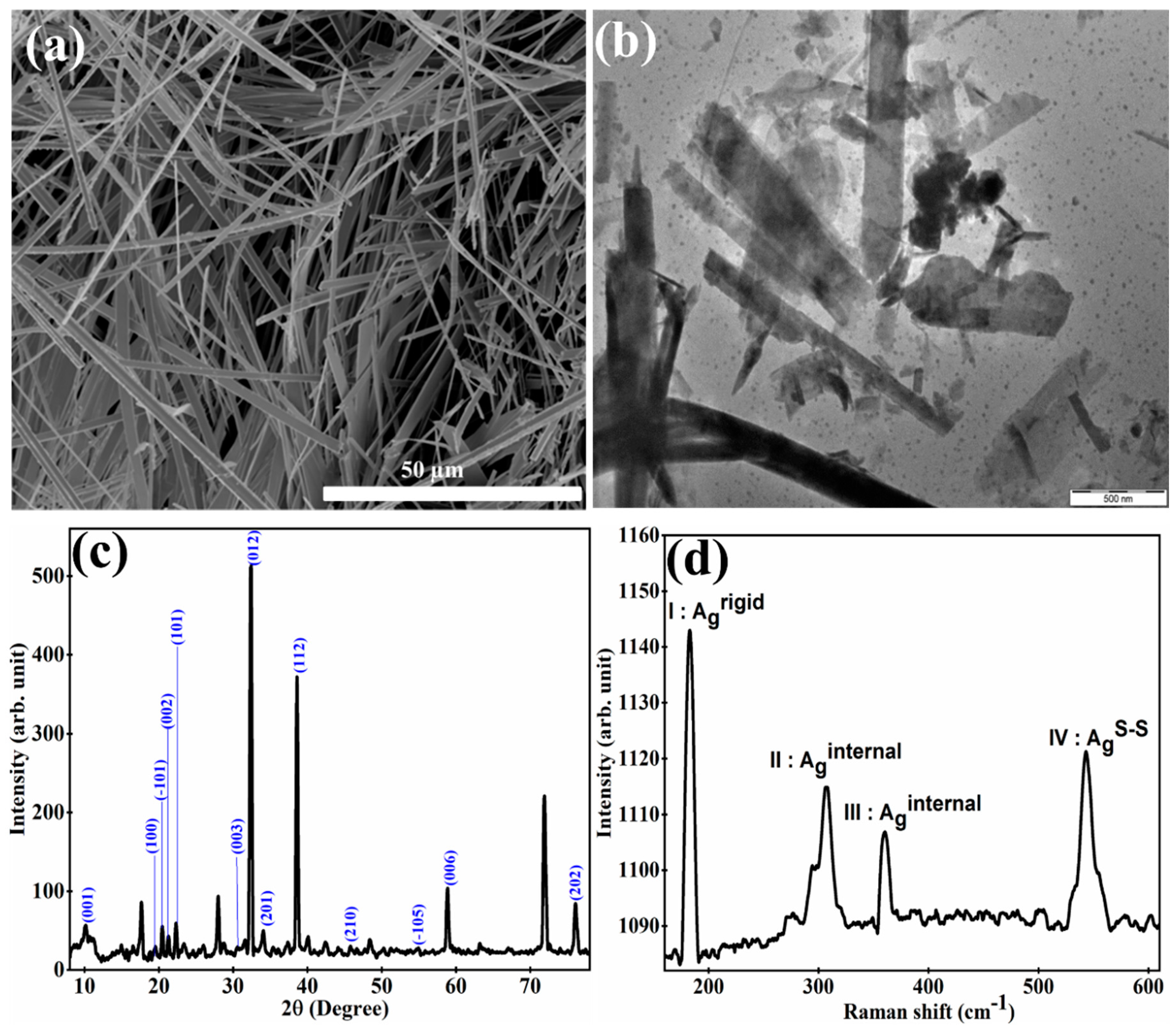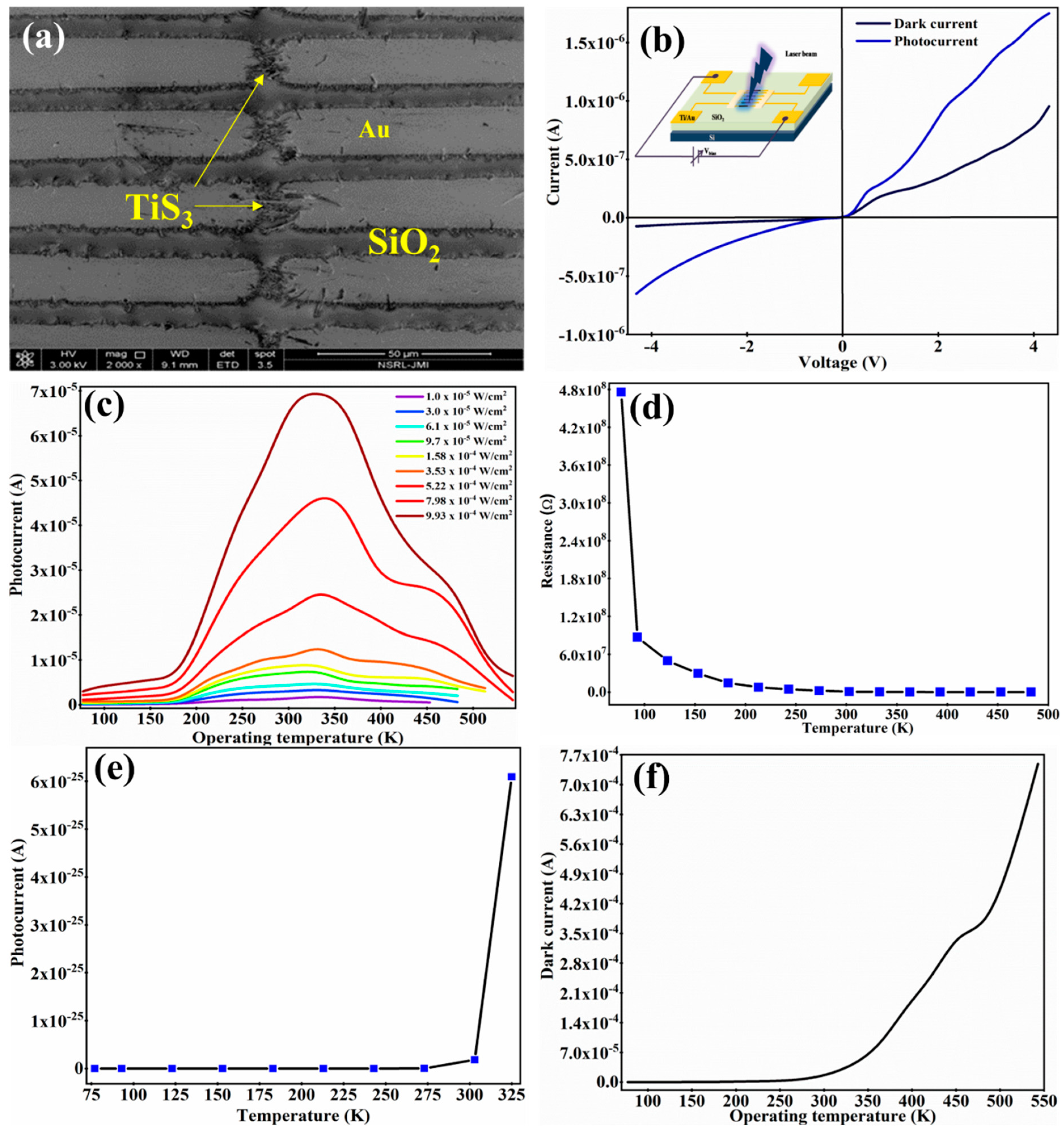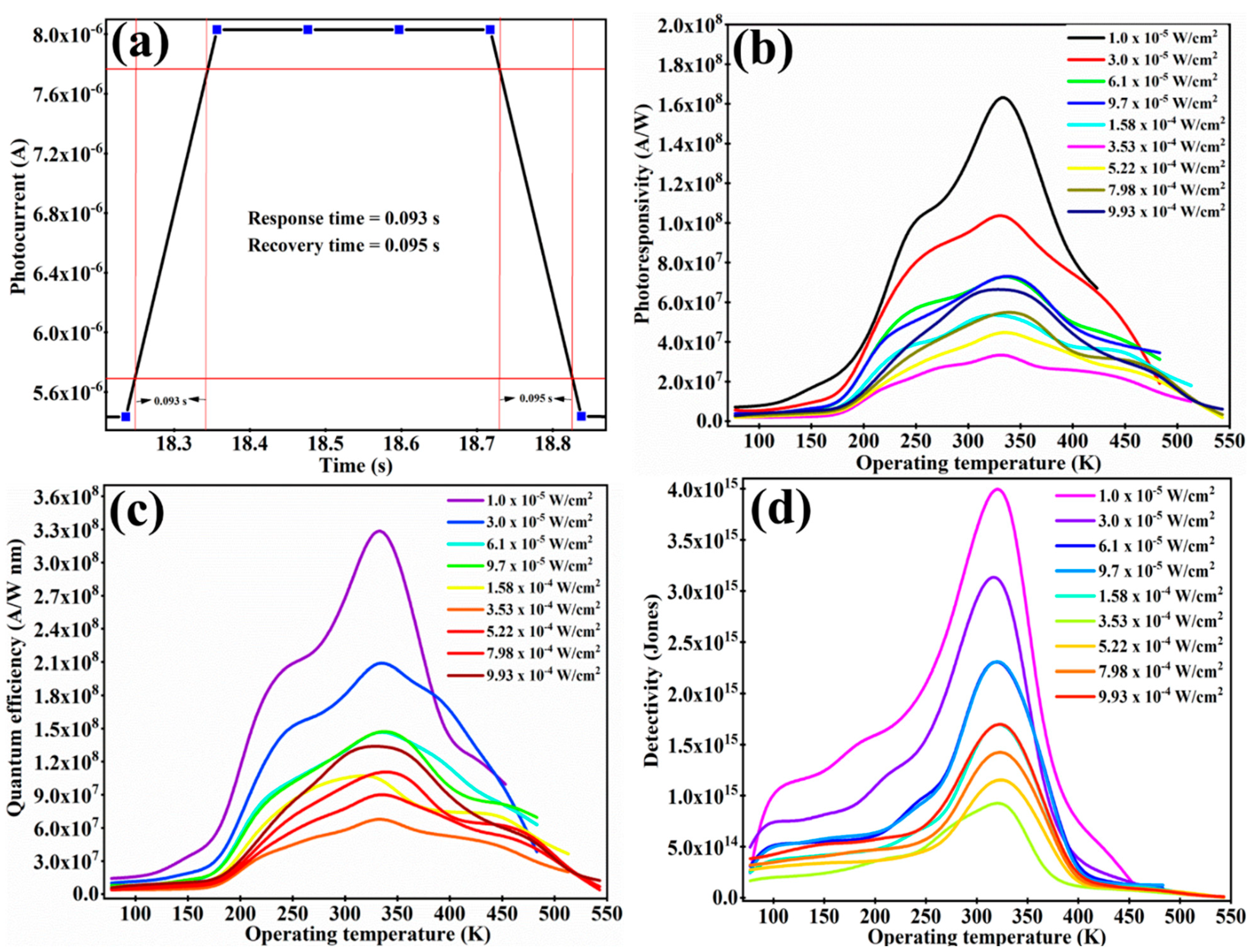TiS3 Nanoribbons: A Novel Material for Ultra-Sensitive Photodetection across Extreme Temperature Ranges
Abstract
:1. Introduction
2. Experimental Section
3. Result and Discussion
3.1. Material Characterization
3.2. Investigation of Photoresponse
4. Conclusions
Supplementary Materials
Author Contributions
Funding
Institutional Review Board Statement
Informed Consent Statement
Data Availability Statement
Acknowledgments
Conflicts of Interest
References
- Tao, Q.; Guo, Z.; Xu, Q.; Jiao, W.; Wang, X.; Qu, S.; Gao, J. Retrieving the polarization information for satellite-to-ground light communication. J. Opt. 2015, 17, 085701. [Google Scholar] [CrossRef]
- Talib, M.; Manzoor, S.; Sharma, P.; Tripathi, N.; Platonov, V.; Pavelyev, V.; Volkov, V.S.; Arsenin, A.V.; Syuy, A.V.; Hasan, P.; et al. Development of high-performance broadband optical detector for cryogenic to elevated operating temperature. Mater. Sci. Semicond. Process. 2023, 158, 107364. [Google Scholar] [CrossRef]
- Ganichev, S.D.; Prettl, W. Spin Photocurrents in Quantum wells. J. Phys.-Condens. Matter 2003, 15, 935–983. [Google Scholar] [CrossRef]
- Chen, C.; Chen, J.; Wang, T.; Liu, M. Abrication of Helical Nanoribbon Polydiacetylene via Supramolecular Gelation: Circularly Polarized Luminescence and Novel Diagnostic Chiroptical Signals for Sensing. ACS Appl. Mater. Interfaces 2016, 8, 30608–30615. [Google Scholar] [CrossRef] [PubMed]
- Nordsieck, K.H.; Jaehnig, K.P.; Burgh, E.B.; Kobulnicky, H.A.; Percival, J.W.; Smith, M.P. Instrumentation for high-resolution spectropolarimetry in the visible and far-ultraviolet. Polarim. Astron 2003, 4843, 170–179. [Google Scholar] [CrossRef]
- Yu, Y.; Wang, W.; Li, W.; Wang, G.; Wang, Y.; Lu, Z.; Li, S.; Zhao, W.; Li, Y.; Liu, T.; et al. Photodetectors Based on Micro-nano Structure Material. Front. Chem. 2022, 9, 832028. [Google Scholar] [CrossRef] [PubMed]
- Ha, M.; Lim, S.; Ko, H. Wearable and flexible sensors for user-interactive health-monitoring devices. J. Mater. Chem. B 2018, 6, 4043–4064. [Google Scholar] [CrossRef]
- Abid; Sehrawat, P.; Islam, S.; Gulati, P.; Talib, M.; Mishra, P.; Khanuja, M. Development of highly sensitive optical sensor from carbon nanotube-alumina nanocomposite free-standing films: CNTs loading dependence sensor performance Analysis. Sensors Actuators A Phys. 2018, 269, 62–69. [Google Scholar] [CrossRef]
- Liu, Y.; Wang, H.; Zhao, W.; Zhang, M.; Qin, H.; Xie, Y. Flexible, Stretchable Sensors for Wearable Health Monitoring: Sensing Mechanisms, Materials, Fabrication Strategies and Features. Sensors 2018, 18, 645. [Google Scholar] [CrossRef]
- Bernardes, E.; Viollet, S.; Raharijaona, T. A Three-Photo-Detector Optical Sensor Accurately Localizes a Mobile Robot Indoors by Using Two Infrared Light-Emitting Diodes. IEEE Access 2020, 8, 87490–87503. [Google Scholar] [CrossRef]
- Chang, W.-R.; Fang, Y.-K.; Ting, S.-F.; Tsair, Y.-S.; Chang, C.-N.; Lin, C.-Y.; Chen, S.-F. The hetero-epitaxial SiCN/Si MSM photodetector for high-temperature deep-UV detecting applications. IEEE Electron Device Lett. 2003, 24, 565–567. [Google Scholar] [CrossRef]
- Zhang, Y.; Feng, Q.; Hao, R.; Zhang, M. Fabrication of Large-Area Short-Wave Infrared Array Photodetectors under High Operating Temperature by High Quality PtS2 Continuous Films. Electronics 2022, 11, 838. [Google Scholar] [CrossRef]
- Soa, H.; Park, W. Attachable freezing-delayed surfaces for ultraviolet sensing using GaN photodetector at low temperature in air. Appl. Surf. Sci. 2019, 473, 261–265. [Google Scholar] [CrossRef]
- Ackerman, M.M.; Tang, X.; Guyot-Sionnest, P. Fast and Sensitive Colloidal Quantum Dot Mid-Wave Infrared Photodetectors. ACS Nano 2018, 12, 7264–7271. [Google Scholar] [CrossRef] [PubMed]
- Daumer, V.; Gramich, V.; Müller, R.; Schmidt, J.; Rutz, F.; Stadelmann, T.; Wörl, A.; Rehm, R. Photodetector development at Fraunhofer IAF: From LWIR to SWIR operating from cryogenic close to room temperature. Infrared Technol. Appl. XLIII 2017, 10177, 178–184. [Google Scholar] [CrossRef]
- Stiff, A.D.; Krishna, S.; Bhattacharya, P.; Kennerly, S.W. Normal-Incidence, High-Temperature, Mid-Infrared, InAs–GaAs Vertical Quantum-Dot Infrared Photodetector. IEEE J. Quantum Electron. 2001, 37, 1412. [Google Scholar] [CrossRef]
- Liu, H.C.; Song, C.Y.; SpringThorpe, A.J. Terahertz quantum-well photodetector. Appl. Phys. Lett. 2004, 84, 4068. [Google Scholar] [CrossRef]
- Abakumov, V.N.; Perel, V.I.; Yassievich, I.N. Nonradiative Recombination in Semiconductors; Elsevier: Amsterdam, The Netherlands, 1991; Volume 33. [Google Scholar]
- Chang, Y.; Wang, J.; Wu, F.; Tian, W.; Zhai, W. Structural Design and Pyroelectric Property of SnS/CdS Heterojunctions Contrived for Low-Temperature Visible Photodetectors. Adv. Funct. Mater. 2020, 30, 2001450. [Google Scholar] [CrossRef]
- Chen, Y.; Li, J.; Yang, X.; Zhou, Z.; Sun, C.Q. Band Gap Modulation of the IV, IIIV, and IIVI Semiconductors by Controlling the Solid Size and Dimension and the Temperature of Operation. J. Phys. Chem. C 2011, 115, 23338–23343. [Google Scholar] [CrossRef]
- Que, R.; Shao, Q.; Li, Q.; Shao, M.; Cai, S.; Wang, S.; Lee, S.-T. Flexible Nanogenerators Based on Graphene Oxide Films for Acoustic Energy Harvesting. Angew. Chem. Int. Ed. 2012, 51, 5418–5422. [Google Scholar] [CrossRef]
- Sehrawat, P.; Islam, S.S. Graphene quantum dot arrays: Pros and cons of photodetection in the Coulomb blockade regime. Carbon 2019, 149, 499–511. [Google Scholar]
- Tripathi, N.; Pavelyev, V.; Sharma, P.; Kumar, S.; Rymzhina, A.; Mishra, P. Review of titanium trisulfide (TiS3): A novel material for next generation electronic and optical devices. Mater. Sci. Semicond. Process. 2021, 127, 105699. [Google Scholar] [CrossRef]
- Dai, X.; Cheng, Z. Titanium trisulfide monolayer:theoretical prediction of a new direct-gap semiconductor with high and anisotropic carrier mobility. Angew. Chem. Int. Ed. 2015, 54, 7572–7576. [Google Scholar] [CrossRef] [PubMed]
- Island, J.O.; Biele, R.; Barawi, M.; Clamagirand, J.M.; Ares, J.R.; Sánchez, C.; van der Zant, H.S.J.; Ferrer, I.J.; D’agosta, R.; Castellanos-Gomez, A. Titanium trisulfide (TiS3): A 2D semiconductor with quasi-1D optical and electronic properties. Sci. Rep. 2016, 6, 22214. [Google Scholar] [CrossRef]
- Saiz, F.; Carrete, J.; Rurali, R. Anisotropic Thermal Conductivity in Few-Layer and Bulk Titanium Trisulphide from First Principles. Nanomaterials 2020, 10, 704. [Google Scholar] [CrossRef] [PubMed]
- Sun, G.; Wei, Z.; Chen, N.; Chen, G.; Wang, C.; Du, F. Quasi-1D TiS3: A potential anode for high-performance sodium-ion storage. Chem. Eng. J. 2020, 388, 124305. [Google Scholar] [CrossRef]
- Talib, M.; Tabassum, R.; Abid; Islam, S.S.; Mishra, P. Improvements in the Performance of a Visible–NIR Photodetector Using Horizontally Aligned TiS3 Nanoribbons. ACS Omega 2019, 4, 6180–6191. [Google Scholar] [CrossRef] [PubMed]
- Liu, S.; Xiao, W.; Zhong, M.; Pan, L.; Wang, X.; Deng, H.-X.; Liu, J.; Li, J.; Wei, Z. Highly polarization sensitive photodetectors based on quasi-1D titanium trisulfide (TiS3). Nanotechnology 2018, 29, 184002. [Google Scholar] [CrossRef]
- Ferrer, I.J.; Ares, J.R.; Clamagirand, J.M.; Barawi, M.; Sánchez, C. Optical properties of titanium trisulphide (TiS3) thin films. Thin Solid Films 2013, 535, 398–401. [Google Scholar] [CrossRef]
- Lipatov, A.; Loes, M.J.; Lu, H.; Dai, J.; Patoka, P.; Vorobeva, N.S.; Muratov, D.S.; Ulrich, G.; Kastner, B.; Hoehl, A.; et al. Quasi-1D TiS3 nanoribbons: Mechanical exfoliation and thickness-dependent Raman spectroscopy. ACS Nano 2018, 12, 12713–12720. [Google Scholar] [CrossRef]
- Molina-Mendoza, A.J.; Island, J.O.; Paz, W.S.; Clamagirand, J.M.; Ares, J.R.; Flores, E.; Leardini, F.; Sánchez, C.; Agraït, N.; Rubio-Bollinger, G.; et al. High current density electrical breakdown of TiS3 nanoribbon-based field-effect transistors. Adv. Funct. Mater. 2017, 27, 1605647. [Google Scholar] [CrossRef]
- Ghasemi, F.; Frisenda, R.; Flores, E.; Papadopoulos, N.; Biele, R.; Perez de Lara, D.; Van der Zant, H.S.; Watanabe, K.; Taniguchi, T.; D’Agosta, R.; et al. Tunable photodetectors via in situ thermal conversion of TiS3 to TiO2. Nanomaterials 2020, 10, 711. [Google Scholar] [CrossRef]
- Okeil, S.; Yadav, S.; Bruns, M.; Zintler, A.; Molina-Luna, L.; Schneider, J.J. Photothermal catalytic properties of layered titanium chalcogenide nanomaterials. Dalton Trans. 2020, 49, 1032–1047. [Google Scholar] [CrossRef] [PubMed]
- Abid; Sehrawat, P.; Islam, S.S.; Mishra, P.; Ahmad, S. Reduced graphene oxide (rGO) based wideband optical sensor and the role of Temperature, Defect States and Quantum Efficiency. Sci. Rep. 2018, 8, 3537. [Google Scholar] [CrossRef] [PubMed]
- Low, T.; Engel, M.; Steiner, M.; Avouris, P. Origin of photoresponse in black phosphorus phototransistors. Phys. Rev. B 2014, 90, 081408. [Google Scholar] [CrossRef]
- Randle, M.; Lipatov, A.; Kumar, A.; Kwan, C.P.; Nathawat, J.; Barut, B.; Yin, S.; He, K.; Arabchigavkani, N.; Dixit, R.; et al. Gate-controlled metal-insulator transition in TiS3 nanowire field-effect transistors. ACS Nano 2019, 13, 803–811. [Google Scholar] [CrossRef] [PubMed]
- Ottaviani, G.; Canali, C.; Quaranta, A.A. Charge Carrier Transport Properties of Semiconductor Materials Suitable for Nuclear Radiation Detectors. IEEE Trans. Nucl. Sci. 1975, 22, 192–204. [Google Scholar] [CrossRef]
- Buscema, M.; Island, J.O.; Groenendijk, D.J.; Blanter, S.I.; Steele, G.A.; van der Zant, H.S.J.; Castellanos-Gomez, A. Photocurrent generation with two-dimensional van der Waals semiconductors. Chem. Soc. Rev. 2015, 44, 3691–3718. [Google Scholar] [CrossRef]
- Manik, N.; Basu, A.; Mukherjee, S. Characterisation of the photodetector and light emitting diode at above liquid nitrogen temperature. Cryogenics 2000, 40, 341–344. [Google Scholar] [CrossRef]
- Ilegems, M.; Montgomery, H. Electrical properties of n-type vapor-grown gallium nitride. J. Phys. Chem. Solids 1973, 34, 885–895. [Google Scholar] [CrossRef]
- Abid, A.; Sehrawat, P.; Islam, S.S. Broadband photodetection in wide temperature range: Layer-by-layer exfoliation monitoring of WS2 bulk using microscopy and spectroscopy. J. Appl. Phys. 2019, 125, 154303. [Google Scholar] [CrossRef]
- Klipstein, P. “XBn” Barrier Photodetectors for High Sensitivity and High Operating Temperature Infrared Sensors. Infrared Technol. Appl. XXXIV 2008, 6940, 935–946. [Google Scholar]
- Jiménez-Arévalo, N.; Flores, E.; Giampietri, A.; Sbroscia, M.; Betti, M.G.; Mariani, C.; Ares, J.R.; Ferrer, I.J.; Leardini, F. Borocarbonitride Layers on Titanium Dioxide Nanoribbons for Efficient Photoelectrocatalytic Water Splitting. Materials 2021, 14, 5490. [Google Scholar] [CrossRef]
- Mills, A.; Elliott, N.; Parkin, I.P.; O’Neill, S.A.; Clark, R.J. Novel TiO2 CVD films for semiconductor photocatalysis. J. Photochem. Photobiol. A Chem. 2002, 151, 171–179. [Google Scholar] [CrossRef]
- Lopez-Sanchez, O.; Lembke, D.; Kayci, M.; Radenovic, A.; Kis, A. Ultrasensitive photodetectors based on monolayer MoS2. Nat. Nanotechnol. 2013, 8, 497–501. [Google Scholar] [CrossRef]
- Konstantatos, G.; Howard, I.; Fischer, A.; Hoogland, S.; Clifford, J.; Klem, E.; Levina, L.; Sargent, E.H. Ultrasensitive solution-cast quantum dot photodetectors. Nature 2006, 442, 180–183. [Google Scholar] [CrossRef]
- Zhang, Y.; Du, J.; Wu, X.; Zhang, G.; Chu, Y.; Liu, D.; Zhao, Y.; Liang, Z.; Huang, J. Ultrasensitive Photodetectors Based on Island-Structured CH3NH3PbI3 Thin Films. ACS Appl. Mater. Interfaces 2015, 7, 21634–21638. [Google Scholar] [CrossRef]
- Feng, J.; Gong, C.; Gao, H.; Wen, W.; Gong, Y.; Jiang, X.; Zhang, B.; Wu, Y.; Wu, Y.; Fu, H.; et al. Single-crystalline layered metal-halide perovskite nanowires for ultrasensitive photodetectors. Nat. Electron. 2018, 1, 404–410. [Google Scholar] [CrossRef]
- Zhang, Y.; Hellebusch, D.J.; Bronstein, N.D.; Ko, C.; Ogletree, D.F.; Salmeron, M.; Alivisatos, A.P. Ultrasensitive photodetectors exploiting electrostatic trapping and percolation transport. Nat. Commun. 2016, 7, 11924. [Google Scholar] [CrossRef]
- Liu, Y.; Huang, W.; Gong, T.; Su, Y.; Zhang, H.; He, Y.; Liu, Z.; Yu, B. Ultra-sensitive near-infrared graphene photodetectors with nanopillar antennas. Nanoscale 2017, 9, 17459–17464. [Google Scholar] [CrossRef]
- Talib, M.; Tripathi, N.; Sharma, P.; Hasan, P.; Melaibari, A.A.; Darwesh, R.; Arsenin, A.V.; Volkov, V.S.; Yakubovsky, D.I.; Kumar, S.; et al. Development of ultra-sensitive broadband photodetector: A detailed study on hidden photodetection-properties of TiS2 nanosheets. J. Mater. Res. Technol. 2021, 14, 1243–1254. [Google Scholar] [CrossRef]
- Kang, M.A.; Kim, S.J.; Song, W.; Chang, S.J.; Park, C.Y.; Myung, S.; Lim, J.; Lee, S.S.; An, K.S. Fabrication of flexible optoelectronic devices based on MoS2/graphene hybrid patterns by a soft lithographic patterning method. Carbon 2017, 116, 167–173. [Google Scholar] [CrossRef]
- Wu, D.; Xu, Y.; Zhou, H.; Feng, X.; Zhang, J.; Pan, X.; Gao, Z.; Wang, R.; Ma, G.; Tao, L.; et al. Ultrasensitive, flexible perovskite nanowire photodetectors with long-term stability exceeding 5000 h. InfoMat 2022, 4, e12320. [Google Scholar] [CrossRef]




| S. No. | Material | Operating Temperature (K) | Wavelength (nm) | Power Density of Light (W/cm2) | Photocurrent (A) | Photoresponsivity (A/W) | Response/Recovery Time (s) | Detectivity (Jones) | Ref. |
|---|---|---|---|---|---|---|---|---|---|
| 1. | MoS2 | Room temperature | 561 | 238 | ~10−5 | 880 | 4/9 | - | [46] |
| 2. | PbS colloidal quantum dot | Room temperature | 975 | 80 pW | - | 1000 | in ms | 1.8 × 1013 | [47] |
| 3. | CH3NH3PbI3 | 373 | 400–800 | 0.00659 | ~10−5 | - | 0.04/0.05 | - | [48] |
| 4. | Metal-halide perovskite nanowires | Room temperature | 530 | 8.7 × 10−8 | ~10−4 | 1.5 × 104 | 27.6 × 10−6/24.5 × 10−6 | 7 × 1015 | [49] |
| 5. | CdTe | Room temperature | 500 | 5 × 10−12 | ~10−4 | 4 × 109 | 10 × 10−3/10 | 5 × 1017 | [50] |
| 6. | Graphene | Room temperature | 850 | - | - | 7 | - | - | [51] |
| 7. | TiS2 nanosheets | Room temperature | 455 | 0.0792 | 1.34 × 10−5 | 1.174 × 104 | 0.3/0.18 | 3.039 × 1011 | [52] |
| 8. | TiS2 nanosheets | 93–423 | 617 | 7.92 × 10−4 | 4.52 × 10−8 | 8.9 × 104 | 0.099/0.099 | 1.93 × 1014 | [2] |
| 9. | ZnS–MoS2 | Room temperature | 780 | 1.91 × 10−2 | 1.5 × 10−6 | 4.5 9 × 10–6 | 31/30 | - | [53] |
| 10. | MAPbI3 | Room temperature | - | 0.145 | ~10−5 | 37.14 | 9.1 × 10−5/5.63 × 10−4 | 2.06 × 1013 | [54] |
| 11. | TiS3 nanoribbon | 77 K–543 K | 617 | 1 × 10−5–9.93 × 10−4 | 6.95 × 10−5 | 1.624 × 108 | 0.093/0.093 | 4.328 × 1015 | Present work |
Disclaimer/Publisher’s Note: The statements, opinions and data contained in all publications are solely those of the individual author(s) and contributor(s) and not of MDPI and/or the editor(s). MDPI and/or the editor(s) disclaim responsibility for any injury to people or property resulting from any ideas, methods, instructions or products referred to in the content. |
© 2023 by the authors. Licensee MDPI, Basel, Switzerland. This article is an open access article distributed under the terms and conditions of the Creative Commons Attribution (CC BY) license (https://creativecommons.org/licenses/by/4.0/).
Share and Cite
Talib, M.; Tripathi, N.; Manzoor, S.; Sharma, P.; Pavelyev, V.; Volkov, V.S.; Arsenin, A.V.; Novikov, S.M.; Mishra, P. TiS3 Nanoribbons: A Novel Material for Ultra-Sensitive Photodetection across Extreme Temperature Ranges. Sensors 2023, 23, 4948. https://doi.org/10.3390/s23104948
Talib M, Tripathi N, Manzoor S, Sharma P, Pavelyev V, Volkov VS, Arsenin AV, Novikov SM, Mishra P. TiS3 Nanoribbons: A Novel Material for Ultra-Sensitive Photodetection across Extreme Temperature Ranges. Sensors. 2023; 23(10):4948. https://doi.org/10.3390/s23104948
Chicago/Turabian StyleTalib, Mohammad, Nishant Tripathi, Samrah Manzoor, Prachi Sharma, Vladimir Pavelyev, Valentyn S. Volkov, Aleksey V. Arsenin, Sergey M. Novikov, and Prabhash Mishra. 2023. "TiS3 Nanoribbons: A Novel Material for Ultra-Sensitive Photodetection across Extreme Temperature Ranges" Sensors 23, no. 10: 4948. https://doi.org/10.3390/s23104948





